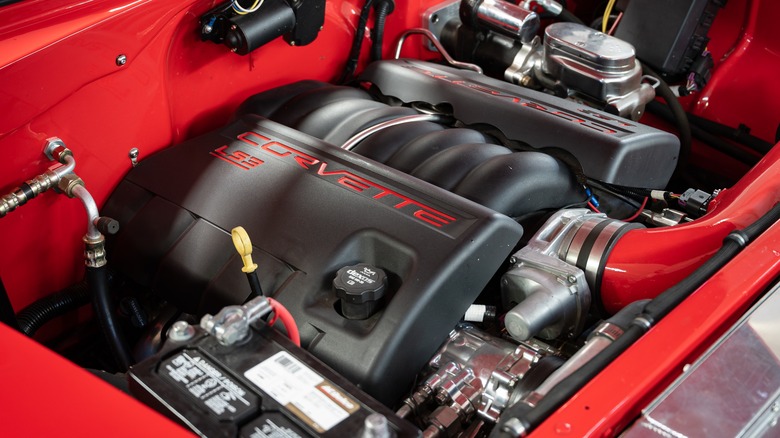LS3 Vs. L99 Engine: What's The Difference & Which Is Faster?
If the Chevrolet Corvette is known for one thing, it's speed. Speed is relative, though, and our expectations have grown over the years. Every Corvette generation has beefed up the specs, and one particularly notable step came with the 2008 C6 Corvette and its LS3 engine. The 6.2L V8 produced 430 horsepower and 424 lb-ft of torque, making the LS3 a truly special engine at the time. The V8 powered the Corvette from 2008 until 2013, and it remains a fan favorite in both the Corvette and aftermarket communities due to its ample power production, durability, and overall drivability.
Beyond the Corvette, the LS3 was used in models like the Chevy Camaro from 2010 until 2015. It was only used in the higher-trim SS models with a manual transmission. Camaro SS models with an automatic transmission also received a 6.2L V8, but not the LS3. That engine, the L99, is nearly identical to the LS3, but with some key differences. Specifically, the L99 added Active Fuel Management and variable valve timing, and it was slightly less powerful than the LS3, totaling 400 horsepower and 410 lb-ft of torque.
The L99 uses AFM and VVT
Both the LS3 and L99 were built on the fourth-generation GM small block architecture. Both engines are 6.2-liter pushrod V8s that use Gen IV rectangular port cylinder heads. While the two engines are more similar than they are different, the L99's valvetrain is one of the most important differences between them. By the late 2000s, GM was slowly introducing variable valve timing (VVT) to their small block V8s to improve both performance and fuel efficiency. The L99's VVT system helped the engine adjust to different situations, providing better fuel economy.
The L99 was also given Active Fuel Management, GM's version of cylinder deactivation technology. In low-demand driving situations, like cruising at steady speeds or sitting in traffic, the L99's AFM system shuts down four cylinders until all eight are needed again. That made the L99 more fuel-efficient than the LS3, but the engine suffered a bit of power as a result. AFM is a somewhat polarizing feature in the enthusiast community since it negatively impacts performance and is known to have reliability problems.
The LS3 is faster and more powerful
Introducing new engine technology isn't as simple as slapping on a few new parts and calling it a day. That's certainly true about the addition of variable valve timing and Active Fuel Management on the L99. To accommodate the new features, other aspects of the LS3's underlying construction had to be adjusted, which is a major reason why the L99 doesn't provide the same level of performance as the LS3.
The L99's use of variable valve timing led to some pretty notable changes to its valvetrain. It uses heavier intake valves, allowing the LS3 to rev higher than the L99. The variable valve timing system also required the L99 to use reliefs for additional valve clearance. The L99's valve relief pistons reduced the engine's compression ratio to 10.4:1 compared to the LS3's 10.7:1.
Both the variable valve timing and Active Fuel Management systems also required the L99 to use a different camshaft with reduced duration and valve lift. It's also important to remember that the LS3 and L99 were designed around two different transmissions, with the former designed for the Corvette's manual and the latter for the Camaro's automatic. While old-school automatics are generally slower, GM did a good job gearing the L99's automatic, as it got the Camaro SS to 60 miles per hour 0.2 seconds faster than the manual LS3 Camaro SS. However, the LS3 proved faster in the quarter mile by 0.1 seconds in the manual SS.


